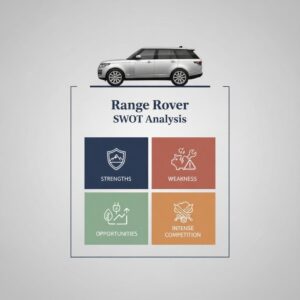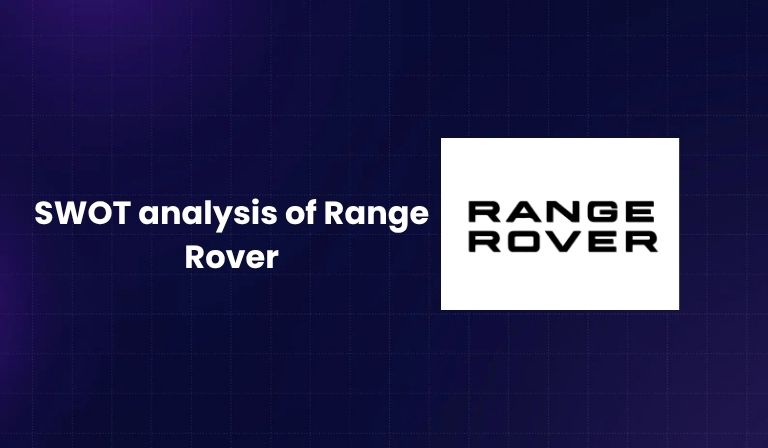Range Rover is a British luxury SUV line from Jaguar Land Rover. The brand stands for luxury, design, and all-terrain ability. This swot analysis of Range Rover explains where the brand is strong, where it struggles, what growth paths exist, and what risks it faces. The goal is clear insight in simple language.
Executive summary
- Position: Luxury SUV icon with real off-road hardware.
- Strengths: Heritage, design, capability, high personalization, global appeal.
- Weaknesses: Reliability perception, high ownership cost, service gaps across markets.
- Opportunities: Electrification, software services, growth in emerging markets, sustainability.
- Threats: Intense luxury SUV competition, regulations, supply chain swings, online reputation risk.
This Range Rover SWOT analysis shows a premium brand that wins on image and capability but must improve ownership experience and tech quality at scale.
Brand background and market context
Brief history
- Range Rover debuted as a luxury 4×4 offshoot of Land Rover.
- It grew from a utility base to a luxury flagship over several generations.
- Jaguar Land Rover sits under Tata Motors ownership since 2008.
Where Range Rover fits
- Range Rover family: luxury focus.
- Defender/Discovery families: adventure and family utility focus.
- Range Rover targets buyers who want comfort, style, and real capability in one car.
Core product lineup (global availability varies)
| Model | Body/Seats | Powertrains (typical) | Core buyer need |
| Range Rover | SUV / up to 7 | Gasoline, mild-hybrid, plug-in hybrid | Flagship luxury and comfort |
| Range Rover Sport | SUV / 5+ | Gasoline, mild-hybrid, plug-in hybrid | Dynamic drive + premium cabin |
| Range Rover Velar | SUV / 5 | Gasoline, mild-hybrid | Clean design + tech focus |
| Range Rover Evoque | SUV / 5 | Gasoline, mild-hybrid | Compact luxury + city use |
Notes: Diesel may exist in select markets. Specifications vary by region and model year.
Target customer and positioning
- Affluent urban buyers, executives, creators, and families.
- Key drivers: brand status, calm ride, quiet cabin, safety, and off-road confidence.
- Main use cases: daily city use, long trips, light to medium trails, and winter roads.
What is a SWOT analysis?

SWOT means Strengths, Weaknesses, Opportunities, Threats. Strengths and weaknesses are internal. Opportunities and threats are external. A swot analysis of Range Rover helps plan product, brand, and service decisions with clear trade-offs.
Strengths
Heritage and brand prestige
Range Rover has a long history in luxury SUVs. Owners link the badge with success, class, and adventure. The name signals status in cities and confidence off-road. This brand power supports pricing and resale.
Iconic design
Range Rover keeps a clear design language: clean lines, upright stance, and balanced proportions. Interiors use simple surfaces and neat layouts. This helps the cars age well and hold appeal across markets.
All-terrain capability
The brand invests in real hardware. Examples include height-adjustable air suspension, multi-terrain drive modes, and strong wading depth by class standards. Drivers use these features on snow, sand, trails, and rough roads. The promise is simple: luxury that can leave the tarmac.
Luxury craftsmanship and personalization
Buyers can pick rich paint finishes, unique wheels, premium leathers, and refined veneers. Commissioned builds often bring higher margins. Personal choices create attachment and word-of-mouth.
Broad lineup coverage
From compact Evoque to long-wheelbase Range Rover, the family covers many needs and budgets within the premium space. This spreads risk and allows model-to-model upgrades as life stages change.
Status symbol effect
Celebrities, business leaders, and creators use Range Rovers. Social media and pop culture keep the image fresh. This reduces price sensitivity for some buyers.
Comfort and cabin tech
Calm ride, seat massage options, air quality systems, and quiet NVH tuning support long trips. Large screens, clean UX, and 3D camera views help daily use.
Global brand awareness
Range Rover has strong presence in the UK, Europe, North America, the Middle East, China, and India. This brings scale and learning across climates and road types.
Read More: SWOT Analysis of Toyota
Weaknesses
Reliability perception
Past reports mention air suspension faults, electronics issues, and warning lights. Even if new models improve, older stories stay online. This reduces trust for first-time buyers.
High cost of ownership
Premium parts, complex systems, and large wheels raise running costs. Insurance is high in many regions. Depreciation can be steep if care is poor or if service history gaps exist.
After-sales variation by market
Service quality, parts lead times, and technician skill can vary across dealers and countries. A weak dealer makes a strong car feel weak. Owners talk about this online.
Fuel economy and emissions on some trims
Large engines and heavy bodies can raise consumption in city use. Buyers in low-emission zones want plug-in options or pure EVs to avoid fees or limits.
Complex tech stack
More features raise the chance of bugs. Over-the-air updates help, but software quality must match luxury price tags. A laggy screen can spoil a great cabin.
Premium price positioning
Price gaps vs. some rivals can be wide. High spec builds push prices into ultra-luxury territory. This narrows the addressable base in price-sensitive markets.
Opportunities
Electrification
Plug-in hybrid and full EV variants can lower running costs and unlock city access. Silent drive and instant torque suit luxury SUVs. Clear charging guidance and home install support can raise adoption.
Software and connected services
Predictive maintenance, remote updates, and feature unlocks can add revenue and keep cars fresh. A strong app with clear UX builds trust and daily habit.
Growth in emerging markets
The Middle East, China, and India show strong demand for luxury SUVs. Hot-climate packs, rear seat focus, and long-wheelbase options can match local needs.
Experiential branding
Brand-led off-road schools, curated trips, and owner clubs turn buyers into fans. Content from these events fuels social proof and referrals.
Personalization at scale
Faster build-to-order cycles, unique color libraries, and special trims raise margin and loyalty. Limited runs can drive buzz and waiting lists.
Sustainable materials
Vegan leathers, recycled fabrics, and certified woods reduce impact. Clear lifecycle stories help brand image and policy compliance.
Partnerships
Tech, mapping, audio, and charging partners can speed feature roadmaps. Travel and luxury brand partners can extend lifestyle value.
Threats
Intense competition
Rivals include Mercedes-Benz G-Class/GLS, BMW X7/X5, Porsche Cayenne, Audi Q7/Q8, Bentley Bentayga, Aston Martin DBX, Lamborghini Urus, and Lexus LX. Each brings strong edges in performance, reliability stories, or dealer reach.
Regulatory pressure
Tougher emissions and safety rules add cost and complexity. Non-compliance risks fines or sales limits in key cities.
Macroeconomic cycles
Luxury demand tracks markets, real estate, and founder wealth. Slowdowns can delay purchases or push buyers to certified pre-owned.
Supply chain volatility
Semiconductors, logistics, and raw materials can delay builds and raise costs. Long waits can hurt buyer goodwill.
Technology disruption
New EV brands grow fast. Software-defined vehicles change buyer expectations. A weak digital experience can nullify a great cabin.
Online reputation risk
Owner forums, review sites, and social video amplify service missteps. A few viral clips can undo months of brand work.
Competitor snapshot
| Rival | Edge vs. Range Rover | Range Rover counter |
| Mercedes G-Class | Iconic off-road image, resale | Greater on-road comfort and ride calm |
| BMW X7 | Driver tech, dealer reach | Strong design cachet, status pull |
| Porsche Cayenne | Sporty dynamics | Superior all-terrain features |
| Audi Q8 | Infotainment polish | Broader lineup and image power |
| Bentley Bentayga | Ultra luxury finish | Wider price spread and availability |
| Aston Martin DBX | Exotic badge | Deeper SUV lineage and capability |
| Lexus LX | Reliability story | Higher image in style and design |
TOWS matrix (strategy from SWOT)
S–O: Use strengths to seize opportunities
- Launch high-image plug-in and EV trims that keep design purity and ride comfort.
- Pair off-road heritage with brand travel programs and winter schools in key regions.
W–O: Fix weaknesses with opportunities
- Combat reliability perception with transparent warranty tracks, courtesy vehicles, and live service status in app.
- Lower ownership anxiety with service plans, tire-and-wheel cover, and pickup-drop programs.
S–T: Use strengths to block threats
- Leverage global awareness to run market-specific editions and climate packs.
- Use personalization depth to set features rivals cannot match at the same price band.
W–T: Defend despite weaknesses
- Standardize service KPIs across dealers; publish wait-time and parts-fill goals.
- Speed powertrain shift to lower-emission options to stay ahead of rules.
Product and technology deep-dive
Capability tech
| Feature | Benefit | Buyer value |
| Terrain drive modes | Adapts powertrain and traction | Confidence on snow, sand, gravel |
| Air suspension | Ride height control | Comfort in city; clearance on trails |
| 3D surround cameras | Clear views at low speed | Easy parking and slow off-road moves |
Comfort and cabin
| Feature | Benefit | Buyer value |
| Air quality system | Filters fine particles and odors | Health and comfort on long trips |
| Seat massage and heat/cool | Reduces fatigue | Rested driver and passengers |
| Quiet cabin tuning | Low noise at speed | Calm, luxury feel |
Infotainment and safety
| Feature | Benefit | Buyer value |
| Large touch UI | Simple access to key functions | Shorter learning time |
| OTA updates | Fixes and features without visits | Car improves over time |
| Driver aids | Parking and highway support | Lower stress in traffic |
Materials and sustainability
| Aspect | Example | Value |
| Alternative materials | Non-leather seat options | Choice and impact reduction |
| Recycled content | Fabrics and trims | Clear sustainability story |
Buyer personas
- Executive Urbanite: Values image, quiet cabin, and rear seat space.
- Adventurous Family: Wants safety, space, and winter or trail confidence.
- Style-Led Creator: Seeks design, colors, and social presence.
Triggers: Status, design, comfort, feature list, dealer experience.
Objections: Reliability stories, service wait times, running costs.
Regional view (snapshot)
- US/EU: Emission zones push plug-in and EV interest; strong dealer networks matter.
- Middle East/China: Demand for luxury trims, rear seat focus, and strong AC systems.
- India: SUV form suits roads; duties affect pricing; service reach shapes success.
Risks and mitigations
- Supply risk: Dual-source critical parts; build flexible specs.
- Software bugs: Tight test cycles; staged rollouts; quick rollback plans.
- Reputation: Proactive owner care; fast part swaps; clear communication in app and email.
Conclusion
This Range Rover SWOT analysis shows clear brand power in design and all-terrain skill. The path to growth is clear as well: expand electrified options, raise software quality, and make service simple and fast. If the brand improves reliability perception and delivers smooth digital care, it can keep its luxury SUV lead while meeting new rules and new buyer needs.
FAQs
1) Is Range Rover reliable?
New models show progress, but online stories from older cars still shape views. Clear service plans and strong dealer care help owners feel safe.
2) Which Range Rover is best for families?
Range Rover Sport and Range Rover (7-seat option) suit families who want space, comfort, and safety tech. Evoque works for city-first use with smaller size.
3) Does Range Rover offer hybrids or EVs?
Lineups in many markets include mild-hybrid and plug-in hybrid options. Pure EVs are expanding by model and region.
4) How does Range Rover compare to G-Class?
G-Class leans hard into icon status and rock-crawl image. Range Rover focuses more on cabin calm, design, and daily comfort, while keeping real trail skill.
5) What affects Range Rover ownership cost?
Large wheels, premium tires, complex features, and insurance rates. A service plan and careful driving habits can reduce surprise costs.
A digital marketer with a strong focus on SEO, content creation, and AI tools. Creates helpful, easy-to-understand content that connects with readers and ranks well on search engines. Loves using smart tools to save time, improve content quality, and grow online reach.

